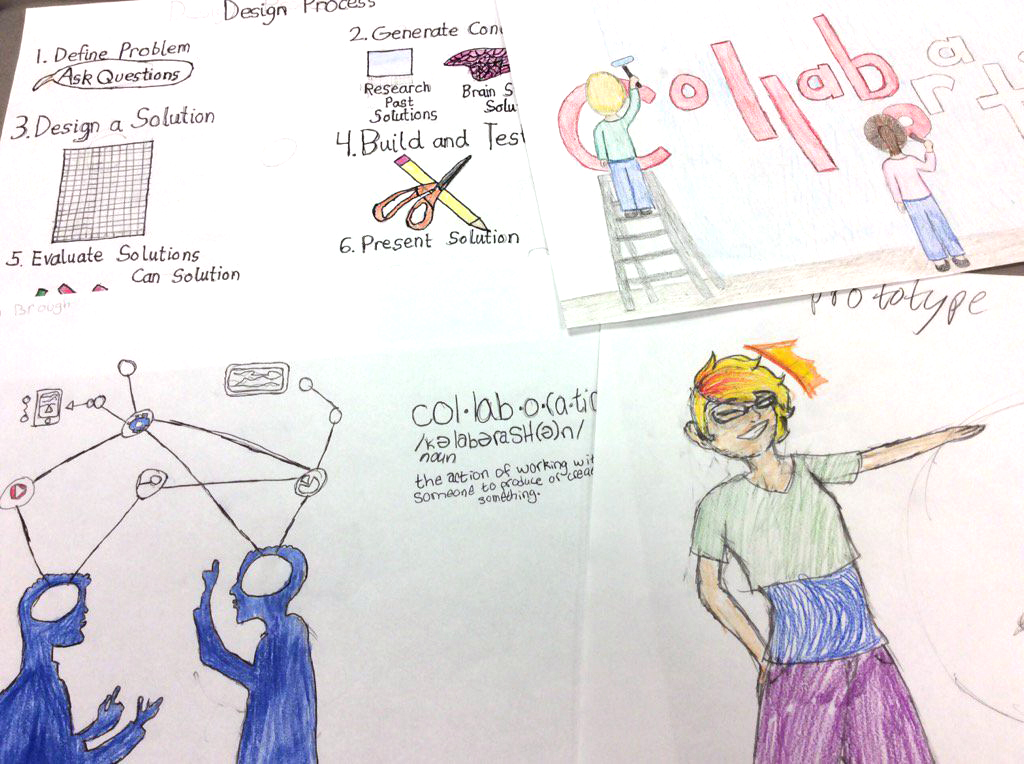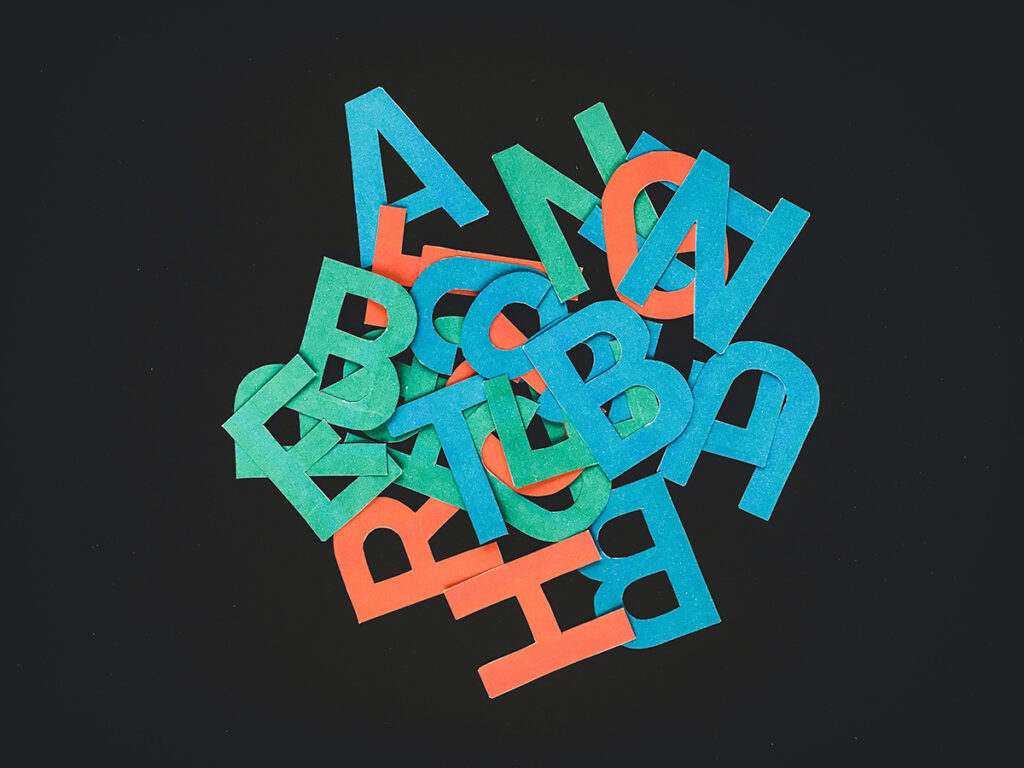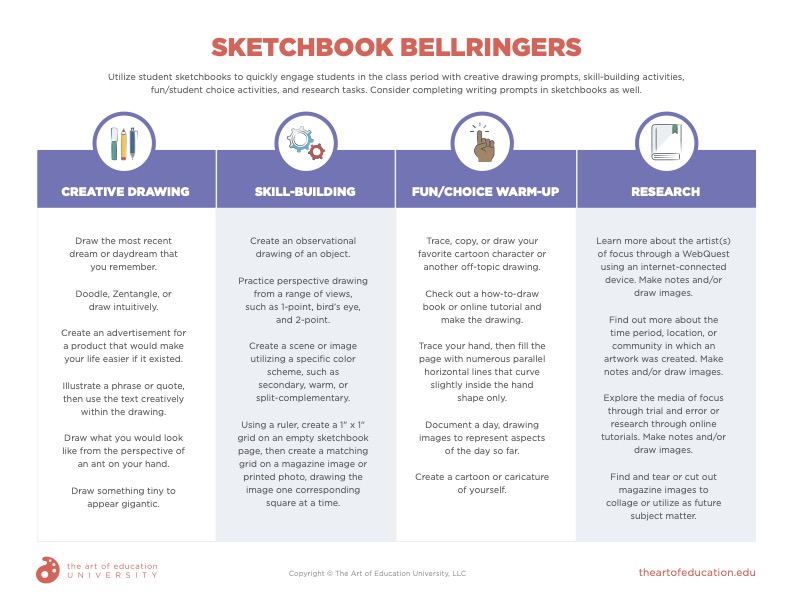Warm-ups, bellringers, hooks, openers, do nows, and anticipatory sets. Whatever you call them, they set the tone and stage for the rest of the class period. At the end of the class, students participate in a closure activity to review and sum up their learning. While it can be helpful to establish a routine and do the same activity at the beginning and end of class, it can also get stale and leave students wanting more. Let’s take a look at a few fun and exciting activities you can weave into your lessons to give them a boost!

Chelsea Fleming is AOEU’s K-12 Professional Development & Curriculum Specialist. Chelsea applies her experience and expertise as a middle school art teacher and instructional coach to our FLEX Collections and PRO Packs. You can find these by heading over to FLEX Curriculum and PRO Learning to learn more. Chelsea reminds teachers of all content areas that warm-up and closure activities are so valuable because “the first and last thing get remembered well.” Setting students up for success with the “first and last thing” includes building a routine and strong expectations.
Here are Chelsea’s top seven tips when it comes to implementing these activities in your art room:
- Accommodate or excuse late students and early dismissals.
Warm-ups and closures, for the most part, are student-directed activities. If a student misses a warm-up or closure activity, they can do it as an early finisher activity later in the period or next class. - Establish expectations.
Start from the beginning by making warm-ups and closures non-negotiable. Students do them, and there are no other options. Students also like consistency so setting this up as a routine is key. - Explain the “why.”
Explicitly tell students how this is not busywork or “just” an extra activity so that you gain their buy-in. Maybe a particular prompt will get their creative juices flowing, or a task will give them more shading practice before a final artwork. Perhaps a short reflection will activate their brains for thinking, or a quick drawing will warm up their hand muscles. - Encourage active participation.
We cannot force students to participate; however, we can set clear expectations and share the purpose behind the activity. If a student is still choosing not to participate, ask yourself (or them!) why. - Set a timer.
Many students appreciate a timer. It can serve as a motivator and convey urgency. - Be present.
This time is great for teachers to multitask—you can prep or clean up to stay on top of your responsibilities. Be mindful that you are still present and available to your students. Ask them questions and compliment them! - Let go of grading.
You would be buried in paperwork if you graded every warm-up and closure! There is no need to grade everything students do, but continue to review their answers and use them as a formative assessment. Provide feedback, so students know these activities are meaningful to you and their learning.
6 Warm-Up Activities for the Art Room
According to a study from Microsoft, we lose focus after only eight seconds. Our attention spans are decreasing due to our digital lifestyle; we see this reflected in our students in the art room. How you start class matters and can dictate how the rest of the period goes. Start strong with an engaging warm-up and enthusiastic attitude to hook your students. Once you find a few formats you and your students like, keep them on a rotation. It will make planning easier for you and be more consistent for your students.
On the topic of bringing technology and screens into the warm-ups, Chelsea reminds us that while these tools are helpful and are typically an easy way to get most students interested, not all of them love technology as we assume. She cautions that breaking screens out for an activity can be difficult to move past later. As such, screens may be better used in an activity later in the period.
Chelsea suggests keeping activities, such as the warm-up, either the same number of minutes as their age or shorter to accommodate the decreasing attention span. Older students do not need to exceed 5-7 minutes, so most of the class can be spent on the lesson’s core. Passion and energy do not mean you need to be theatrical and over-the-top, although if that is your personality, go for it! Purposeful planning and a natural love for visual art are enough to set your warm-ups up for success. Let’s look at some activities below to help you plan with a purpose!
For a deeper dive into ways to hook your students throughout the lesson, check out the Pack, Strategies for Student Engagement, found in PRO Learning. In it, you will find tons of activities and pointers to draw your students’ attention. Download the Bellwork Prompt Ideas for a sneak peek at what this Pack has to offer! It includes lists of activities broken down into categories: sketchbook, writing, thinking, and skill-spiraling.
Download Now!
1. “What if…”
Ask theoretical questions to get students thinking and making creative and reflective connections. Relax and know these are okay to be loosely tied to your lesson plan or curriculum. For example, you can ask, “What if you could be a crayon? What color crayon would you be today and why?” to kick off a color theory lesson.
2. Silly or Serious Sketchbook Drawings
Get those hand muscles warmed up with some quick, low-pressure drawings. Students can review a drawing technique from the last class or generate ideas for an upcoming assignment. They can illustrate an art term or procedure or doodle to relieve stress.

Here are some compilations of our favorite sketchbook prompts. Bookmark and download them now so you always have options on hand.
- 100 Sketchbook Prompts Your Students Will Love
- 100 Silly Drawing Prompts to Engage Your Students
- 50 SEL Sketchbook Prompts to Help Start Your Day
3. Photo of the Day
Project a photo of the day. You can find your own or grab one from National Geographic’s Photo of the Day. Students can share a story of what happened before or after the photo. You can also zoom in on one part of the image and ask students to guess the whole image.
4. Collaborative Story
Post a writing prompt on the board, such as, “Once upon a time….” As students come in, they grab a marker and write a section of the story. This warm-up is a popular one, so if you have a lot of avid writers, add a word limit per student!
5. A, B, C
Provide a topic or theme such as artists, painters, artworks, or supplies. Each student writes one word beginning with A, one word beginning with B, and one word beginning with C. For instance, if the theme is painting supplies, A could be “acrylic,” B could be “brush,” and C could be “canvas.”

6. Memory Lane
Students write down everything they remember from the last class period. By everything, Chelsea means everything! It can include the lesson steps, objective(s), and tasks. It can even include what they wore that day, what they talked to their tablemates about, or what the principal said via the loudspeaker. This warm-up gets students to reflect on the last class and reactivates their memory. When reviewing the answers, you will probably laugh at the funny and weird things students take away. Look for the main concepts covered as a recurring thread.
6 Closure Activities for the Art Room
Closure can be tricky when you have big messes to clean up at the end of class. Chelsea encourages us to “not let your class end at clean up!” Build in time for clean-up and your closure activity. Only after students clean their areas and return to their seats, provide the closure activity. Doing it in this order also helps you see any remaining messes. Let students know cleaning up is a pause in artmaking, and there is one more thing to accomplish. You can also reframe clean-up as “putting our supplies away” to help students see that this is not the end of class. A closure activity can also build anticipation for the next class with a little careful forethought.
1. “I went to the art supply store to buy a…”
This is another alphabet game, but the class works together to complete the activity. One student will start by saying, “I went to the art supply store to buy a…” and will list an art supply starting with the letter A. The second student will repeat the saying, list the first student’s art supply beginning with A, and add a second art supply beginning with the letter B. The game continues until you use all 26 letters or all students have a turn. This is a silly team bonding game to review art materials and supplies. Know your student demographic; this may not be the best game if you have a high population of students who are ELL or have food/product scarcity issues.
2. Stop Light Check
Post a photo of a traffic stop light with each colored circle labeled with the following: red is “Needs More Help,” yellow is “Getting It,” and green is, “I got it!” If projected on a whiteboard or printed and laminated, students can put a tally mark on their circle with a dry-erase marker. Students can also write their names on a sticky note and attach them to the right circle on a larger diagram. For a more anonymous check-in, students write their color light in their sketchbooks for you to check later, or you can set up an online poll.

3. Riddle
Give a riddle or joke to your students. It can be art-themed or loosely connected by subject matter. Disclose the answer next class to get students excited to come back! If your class is getting ready to paint next time, break the news to them by asking, “I am a coat that can only be put on when wet. What am I?” Or, after they start painting and have done color mixing exercises, ask, “What does a momma color wheel say to a baby color wheel?” Tell the students next class, “The momma says, ‘Don’t use that tone with me!’”
4. Guess What’s Next
Show a part of an image or artwork. It can be the first part of a diptych or series. It can also be a zoomed-in closeup. Students guess what happens next, either in the next image or the whole image. Reveal the answer to them in the next class to build suspense!
5. Sentence Stems
A sentence stem is a fill-in-the-blank phrase or sentence. Students write their responses on a sticky note and add them to a designated location in the room on their way out the door. Your sentence stems can be simple, like “I enjoyed ___ the most today!” or more technical, like “One of the watercolor techniques we practiced today is ___.”
6. Similes
Another fun sticky note activity is to provide a simile prompt. A simile involves a comparison of two different things to illustrate a point. You fill in the first blank, and students fill in the second and third blanks, “___ is like ___ because ___.” For instance, after a visual journaling lesson, a simile could be, “Sketchbooks are like cell phones because they record ideas, and you take them everywhere!” Or, after a drawing lesson, “Chalk pastels are like younger siblings because they are always a BIG mess!” Chelsea warns this is another one sure to bring laughter!
Whatever educational lingo you use, warm-up and closure activities are invaluable to student learning despite the short amount of time they use. Establish expectations to tell students this is a routine part of each class. Encourage active participation from all students by using a timer and sharing the purpose of each activity. Give timely feedback and be present while students work to maximize learning and the activity’s success. And go for it! Try the above strategies, tweak them, or come up with your own. Let’s have the first and last thing our students remember about our class be spectacular, so they are anxious to come back for more!
What is a favorite warm-up or closure activity you would add to this list?
How will you cultivate a classroom environment that values the first and last part of the class?
Magazine articles and podcasts are opinions of professional education contributors and do not necessarily represent the position of the Art of Education University (AOEU) or its academic offerings. Contributors use terms in the way they are most often talked about in the scope of their educational experiences.






